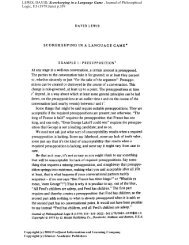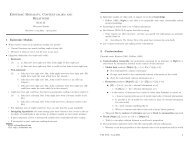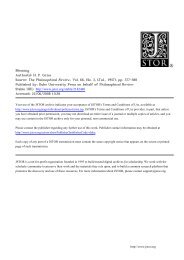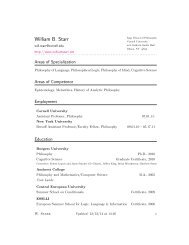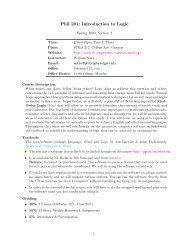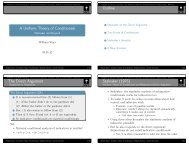Informal Proofs with Quantifiers II (11.10) - Will Starr
Informal Proofs with Quantifiers II (11.10) - Will Starr
Informal Proofs with Quantifiers II (11.10) - Will Starr
You also want an ePaper? Increase the reach of your titles
YUMPU automatically turns print PDFs into web optimized ePapers that Google loves.
Review Universal Introduction General Conditional Proof<br />
Announcements<br />
<strong>11.10</strong><br />
Review Universal Introduction General Conditional Proof<br />
1 Grades for HW1-4, HW6 and Midterm are on Bb<br />
• Check on them, email me <strong>with</strong> questions<br />
• If you’ve already emailed: I’m working through a backlog,<br />
be patient<br />
2 Midterms were returned last Thursday<br />
• If you missed it, come to office hours to claim it<br />
3 There are 3 HWs left<br />
• HW is a big part of your grade<br />
• Make them count!<br />
<strong>Informal</strong> <strong>Proofs</strong> <strong>with</strong> <strong>Quantifiers</strong> <strong>II</strong><br />
Universal <strong>Proofs</strong><br />
<strong>Will</strong>iam <strong>Starr</strong><br />
<strong>11.10</strong>.11<br />
<strong>Will</strong>iam <strong>Starr</strong> | Phil 2310: Intro Logic | Cornell University 1/31<br />
<strong>Will</strong>iam <strong>Starr</strong> | Phil 2310: Intro Logic | Cornell University 2/31<br />
Review Universal Introduction General Conditional Proof<br />
Outline<br />
Review Universal Introduction General Conditional Proof<br />
Two <strong>Informal</strong> Inference Steps<br />
Existential Introduction & Universal Elimination<br />
Existential Introduction (Official Version)<br />
1 Review<br />
2 Universal Introduction<br />
3 General Conditional Proof<br />
S(c)<br />
✄ ∃x S(x)<br />
(When ‘c’ names an object in the domain of discourse)<br />
Universal Elimination (Official Version)<br />
∀x S(x)<br />
✄<br />
S(c)<br />
(Where ‘c’ refers to an object in the domain of discourse)<br />
<strong>Will</strong>iam <strong>Starr</strong> | Phil 2310: Intro Logic | Cornell University 3/31<br />
<strong>Will</strong>iam <strong>Starr</strong> | Phil 2310: Intro Logic | Cornell University 5/31
Review Universal Introduction General Conditional Proof<br />
Two Inference Steps<br />
A Simple Example<br />
Example Argument<br />
1 Tet(a) → ∀x Small(x)<br />
2 ∀y Tet(y)<br />
3 ∃x Small(x)<br />
Proof:<br />
• From 2 by universal<br />
elimination: Tet(a)<br />
• From this and 1 we get by<br />
modus ponens ∀x Small(x)<br />
• Applying universal elimination to this, we get Small(a)<br />
• By existential introduction: ∃x Small(x)<br />
̌<br />
Review Universal Introduction General Conditional Proof<br />
Existential Elimination<br />
Background<br />
• Suppose you are given an existential premise and need to<br />
use it to prove a conclusion<br />
(1) Something is a cube<br />
• Suppose the domain includes only two blocks a and b<br />
• What can you infer from (1)?<br />
• a is a cube? No!<br />
• b is a cube? No!<br />
• Here’s an idea:<br />
• We can infer from (1) that there is some block, call it<br />
Frank, that is a cube<br />
• Then we can continue on in our reasoning as if Frank was a<br />
real name, even though it’s a dummy name (an ersatz)<br />
• This dummy name method turns out to be very useful<br />
<strong>Will</strong>iam <strong>Starr</strong> | Phil 2310: Intro Logic | Cornell University 6/31<br />
<strong>Will</strong>iam <strong>Starr</strong> | Phil 2310: Intro Logic | Cornell University 8/31<br />
Review Universal Introduction General Conditional Proof<br />
Existential Elimination<br />
In Review<br />
Review Universal Introduction General Conditional Proof<br />
Existential Elimination<br />
An Example<br />
The Method of Existential Elimination<br />
1 Given ∃x S(x), you may give a dummy name to (one of) the<br />
object(s) satisfying S(x), say c, and then assume S(c)<br />
2 However, c must be a new name, i.e. one not already in use<br />
in the context of your proof<br />
• Remember, the whole idea of the dummy name is to<br />
remain agnostic about which object(s) satisfy S(x)<br />
• In a proof <strong>with</strong> existential and universal premises:<br />
• Always apply existential elimination before applying<br />
universal elimination<br />
• This will save you space and possible confusion<br />
Example Argument<br />
1 ∀z [Tet(z) ∨ Cube(z)]<br />
2 ∀x [Tet(x) → Small(x)]<br />
3 ∃x ¬Small(x)<br />
4 ∃x Cube(x)<br />
Proof:<br />
• These two facts imply that ¬Tet(a)<br />
• First, we apply existential<br />
elimination to 3<br />
¬Small(a) (note ‘a’ is new)<br />
• From 2 by universal<br />
elimination we get<br />
Tet(a) → Small(a)<br />
• From 2 by universal elimination: Tet(a) ∨ Cube(a)<br />
• So Cube(a) must be true<br />
• By existential introduction: ∃x Cube(x)<br />
̌<br />
<strong>Will</strong>iam <strong>Starr</strong> | Phil 2310: Intro Logic | Cornell University 9/31<br />
<strong>Will</strong>iam <strong>Starr</strong> | Phil 2310: Intro Logic | Cornell University 10/31
Review Universal Introduction General Conditional Proof<br />
Summary<br />
The Steps and Methods So Far<br />
Review Universal Introduction General Conditional Proof<br />
What We’ve Done<br />
Taking Stock<br />
Method of Existential Elimination<br />
1 Given ∃x S(x), you may give a dummy name to (one of) the object(s)<br />
satisfying S(x), say c, and then assume S(c)<br />
2 However, c must be a new name, i.e. one not already in uses in proof<br />
Existential Introduction (Official Version)<br />
✄<br />
S(n)<br />
∃x S(x)<br />
(When ‘n’ names an object in the domain of discourse)<br />
Universal Elimination (Official Version)<br />
✄<br />
∀x S(x)<br />
S(c)<br />
• We’ve learned two inference steps and one proof method<br />
for quantifiers:<br />
1 Universal Elimination, Existential Introduction<br />
2 The Method of Existential Elimination<br />
• What’s missing from this list?<br />
• Universal Introduction<br />
• Universal introduction is a proof method and requires the<br />
appeal to dummy names also<br />
• We’ll start <strong>with</strong> some example inferences<br />
(Where ‘c’ refers to an object in the domain of discourse)<br />
<strong>Will</strong>iam <strong>Starr</strong> | Phil 2310: Intro Logic | Cornell University 11/31<br />
<strong>Will</strong>iam <strong>Starr</strong> | Phil 2310: Intro Logic | Cornell University 13/31<br />
Review Universal Introduction General Conditional Proof<br />
Universal Introduction<br />
Justifying a Universal<br />
Review Universal Introduction General Conditional Proof<br />
Universal Introduction<br />
The Need for a Better Method<br />
• Suppose you are looking at Tarski’s World and there are 3<br />
blocks: a, b and c<br />
• Suppose you are asked to prove the following universal:<br />
(2) ∀x Tet(x)<br />
• How might you go about it?<br />
• Consider each object, and show that it satisfies Tet(x)<br />
• Cumulatively, this process will justify saying that (2) is true<br />
in this world<br />
• Call this method the check-each-object method<br />
• Consider the fact that:<br />
(2) ∀x ¬[Cube(x) ∧ Tet(x)]<br />
This is true of every world<br />
• So, we should be able to prove (2) <strong>with</strong>out considering<br />
particular objects from a particular world<br />
• Further, we should be able to prove it even if there were<br />
infinitely many objects<br />
• These two facts go against the check-each-object-method:<br />
• That method requires you to consider particular objects<br />
from a particular world<br />
• It assumes that it’s possible to finish checking every object<br />
• Let’s look at a more general method<br />
<strong>Will</strong>iam <strong>Starr</strong> | Phil 2310: Intro Logic | Cornell University 14/31<br />
<strong>Will</strong>iam <strong>Starr</strong> | Phil 2310: Intro Logic | Cornell University 15/31
Review Universal Introduction General Conditional Proof<br />
Universal Introduction<br />
An Example from Tarski’s World<br />
Review Universal Introduction General Conditional Proof<br />
Universal Introduction<br />
An Example from the Real World<br />
Anyone who passes Phil 2310 <strong>with</strong> an A is smart<br />
∀x ¬[Cube(x) ∧ Tet(x)]<br />
Proof: Let c be an arbitrary block. If we assume Cube(c) ∧ Tet(c),<br />
then we immediately have a contradiction, since c cannot be both a<br />
cube and a tetrahedron. So it must be true that ¬[Cube(c) ∧ Tet(c)]<br />
But since c was an arbitrarily chosen block, it must be that<br />
∀x ¬[Cube(x) ∧ Tet(x)].<br />
• The key in this proof is the use of a dummy name to talk<br />
about an arbitrary block<br />
Every math major has passed Phil 2310 <strong>with</strong> an A<br />
Every math major has been smart<br />
Proof: Let ‘Jessica’ refer to any one of the math majors. By the<br />
second premise, Jessica must have passed Phil 2310 <strong>with</strong> an A<br />
(universal elimination). Then by the first premise, Jessica must have<br />
been smart. But since Jessica was an arbitrarily chosen math major,<br />
it follows that every math major was smart.<br />
• The key in this proof is the use of a dummy name to talk<br />
about an arbitrary math major<br />
<strong>Will</strong>iam <strong>Starr</strong> | Phil 2310: Intro Logic | Cornell University 16/31<br />
<strong>Will</strong>iam <strong>Starr</strong> | Phil 2310: Intro Logic | Cornell University 17/31<br />
Review Universal Introduction General Conditional Proof<br />
Universal Introduction<br />
The Important Features of Our Proof<br />
Review Universal Introduction General Conditional Proof<br />
Universal Introduction<br />
The Official Formulation<br />
• Notice in our proofs we didn’t need to consider a particular<br />
set of blocks or math majors<br />
• Our proof method was perfectly general: it works<br />
regardless of which set of objects you apply it to<br />
• This generality was achieved by introducing a new name to<br />
talk about an arbitrary object<br />
• That object was an arbitrary representative<br />
• We inferred something about that object<br />
• So the same must follow for every object<br />
• This is the basic idea behind Universal Introduction<br />
Universal Introduction<br />
To prove ∀x S(x):<br />
1 Introduce a new name c to stand for a completely arbitrary<br />
member of the domain of discourse<br />
2 Prove S(c)<br />
3 Conclude ∀x S(x)<br />
• Since c is arbitrary, showing S(c) shows ∀x S(x)<br />
• c’s being arbitrary prevents one from assuming that any<br />
properties specific to one object are used in proof<br />
<strong>Will</strong>iam <strong>Starr</strong> | Phil 2310: Intro Logic | Cornell University 18/31<br />
<strong>Will</strong>iam <strong>Starr</strong> | Phil 2310: Intro Logic | Cornell University 19/31
Review Universal Introduction General Conditional Proof<br />
Universal Introduction<br />
Another Example<br />
Review Universal Introduction General Conditional Proof<br />
Universal Introduction<br />
In Class Exercise<br />
Example Argument<br />
1 ∀x Tet(x)<br />
2 ∀x Medium(x)<br />
3 ∀x (Tet(x) ∧ Medium(x))<br />
Proof:<br />
• Let ‘c’ be an arbitrary block<br />
• From 1 Tet(c) follows by<br />
universal elimination<br />
• Applying universal elimination<br />
to 2 gives us Medium(c)<br />
Give an informal proof for:<br />
1 ∀y (y ≠ b → LeftOf(y, b))<br />
2 ∀x [LeftOf(x, b) → SameSize(x, a)]<br />
3 ∀x ∃y SameSize(x, y)<br />
• So we have Tet(c) ∧ Medium(c)<br />
• But c was arbitrary, so it follows that<br />
∀x (Tet(x) ∧ Medium(x)) ̌<br />
Hint: use universal introduction. Premise 2 says Every block<br />
left of b is the same size as a. The conclusion says that Every<br />
block is the same size as some block or other.<br />
<strong>Will</strong>iam <strong>Starr</strong> | Phil 2310: Intro Logic | Cornell University 20/31<br />
<strong>Will</strong>iam <strong>Starr</strong> | Phil 2310: Intro Logic | Cornell University 21/31<br />
Review Universal Introduction General Conditional Proof<br />
General Conditional Proof<br />
How to Prove a Universal Conditional<br />
Review Universal Introduction General Conditional Proof<br />
Conditional Proof<br />
Review of Conditional Proof<br />
• In practice, we are usually concerned <strong>with</strong> proving<br />
universal claims of these forms:<br />
• Every A is B<br />
• All A are B, etc.<br />
• As we all know, these are translated in fol as:<br />
∀x (A(x) → B(x))<br />
• To prove this using universal introduction you would prove,<br />
for an arbitrary c:<br />
A(c) → B(c)<br />
• This would be achieved using conditional proof:<br />
• Assume A(c) and show B(c)<br />
The Method of Conditional Proof<br />
To prove P → Q, temporarily assume P. If you can show Q <strong>with</strong><br />
this additional assumption, you can infer P → Q<br />
Truth Table for →<br />
P Q P → Q<br />
t t t<br />
t f f<br />
f t t<br />
f f t<br />
• The only way for P → Q to be<br />
f is for P to be true and Q be f<br />
• So, if you can show that when<br />
P is t Q is also t, you’ve<br />
shown that P → Q cannot be<br />
false, i.e. that it is true!<br />
<strong>Will</strong>iam <strong>Starr</strong> | Phil 2310: Intro Logic | Cornell University 23/31<br />
<strong>Will</strong>iam <strong>Starr</strong> | Phil 2310: Intro Logic | Cornell University 24/31
Review Universal Introduction General Conditional Proof<br />
Conditional Proof<br />
Review of Conditional Proof: An Example<br />
Review Universal Introduction General Conditional Proof<br />
Universal Introduction + Conditional Proof<br />
How to Prove a Universal Conditional<br />
Let’s use conditional proof and modus ponens to give a proof of:<br />
Argument 1<br />
Tet(a) → Tet(b)<br />
Tet(b) → Tet(c)<br />
Tet(a) → Tet(c)<br />
Our goal is a conditional, so we use conditional proof.<br />
Proof: Suppose Tet(a). Then by premise 1 Tet(b) follows by<br />
modus ponens. But then we may now again use modus ponens<br />
and premise 2 to infer Tet(c). This is the consequent of our<br />
goal, so we have successfully completed our conditional proof.<br />
∀x Cube(x)<br />
∀x (Small(x) → Cube(x))<br />
Proof: Let c be an arbitrary block. We will show<br />
Small(c) → Cube(c) by conditional proof. Suppose Small(c). By<br />
Premise 1 and Univ. Elim. Cube(c). Thus, the conditional<br />
follows. c was arbitrary so conclusion follows by Univ. Intro.<br />
Important Observation<br />
Proving a universal conditional combines two proof methods:<br />
1 Introducing an arbitrary constant, c<br />
2 Assuming the antecedent holds for it,<br />
3 Showing that the conclusion does too.<br />
<strong>Will</strong>iam <strong>Starr</strong> | Phil 2310: Intro Logic | Cornell University 25/31<br />
<strong>Will</strong>iam <strong>Starr</strong> | Phil 2310: Intro Logic | Cornell University 26/31<br />
Review Universal Introduction General Conditional Proof<br />
General Conditional Proof<br />
Universal Instantiation Plus Conditional Proof<br />
• <strong>Proofs</strong> will often involve using conditional proof &<br />
universal introduction together<br />
• So, let’s introduce a short-cut & name for it<br />
General Conditional Proof<br />
To prove ∀x (A(x) → B(x)):<br />
1 Introduce a new name c to stand for a completely arbitrary<br />
member of the domain of discourse<br />
2 Assume A(c)<br />
3 Prove B(c)<br />
4 Conclude ∀x (A(x) → B(x))<br />
• This is equivalent to using universal introduction along<br />
<strong>with</strong> conditional proof<br />
Review Universal Introduction General Conditional Proof<br />
General Conditional Proof<br />
An Example<br />
Proof:<br />
• Let a name an<br />
arbitrary block<br />
• Suppose Small(a)<br />
(Goal: Show Cube(a))<br />
• From premise 1:<br />
Small(a) → ¬Tet(a)<br />
Example Argument<br />
• By modus ponens, we get ¬Tet(a)<br />
∀x [(Small(x) → ¬Tet(x))<br />
∀x [¬Tet(x) → Cube(x)]<br />
∀x [Small(x) → Cube(x)]<br />
• Premise 2 gives us ¬Tet(a) → Cube(a), so by modus ponens<br />
we have Cube(a), (our goal)<br />
• Since a was arbitrary, it follows that<br />
∀x [Small(x) → Cube(x)] ̌<br />
<strong>Will</strong>iam <strong>Starr</strong> | Phil 2310: Intro Logic | Cornell University 27/31<br />
<strong>Will</strong>iam <strong>Starr</strong> | Phil 2310: Intro Logic | Cornell University 28/31
Review Universal Introduction General Conditional Proof<br />
General Conditional Proof<br />
Another Example<br />
Review Universal Introduction General Conditional Proof<br />
General Conditional Proof<br />
In Class Exercise<br />
Proof:<br />
Example Argument<br />
• Let a name an<br />
arbitrary block<br />
• Suppose Medium(a)<br />
(Goal: Show ¬Smaller(a, c))<br />
∀x [(Cube(x) ∨ Large(x))<br />
∨(Medium(x) ∧ Tet(x))]<br />
∀x [Tet(x) → ¬Smaller(x, c)]<br />
∀x [Medium(x) → ¬Smaller(x, c)]<br />
• From premise 1:<br />
(Cube(a) ∧ Large(a)) ∨ (Medium(a) ∧ Tet(a))<br />
• Since Medium(a), the first disjunct must be false, and<br />
Medium(a) ∧ Tet(a) must be true<br />
• Premise 2 gives us Tet(a) → ¬Smaller(a, c), so by modus<br />
ponens we have ¬Smaller(a, c), (our goal)<br />
• Since a was arbitrary, it follows that<br />
∀x [Medium(x) → ¬Smaller(x, c)] ̌<br />
Give an informal proof for:<br />
1 ∀y [∃x Tet(x) → LeftOf(y, b)]<br />
2 ∀x [LeftOf(x, b) → Smaller(x, a)]<br />
3 ∀x [Tet(x) → Smaller(x, a)]<br />
Hint: use the method of general conditional proof, along <strong>with</strong><br />
universal elimination, existential introduction and modus<br />
ponens.<br />
<strong>Will</strong>iam <strong>Starr</strong> | Phil 2310: Intro Logic | Cornell University 29/31<br />
<strong>Will</strong>iam <strong>Starr</strong> | Phil 2310: Intro Logic | Cornell University 30/31<br />
Review Universal Introduction General Conditional Proof<br />
Universal Proof<br />
Summary<br />
Summary<br />
1 To prove a universally quantified claim, use Universal<br />
Introduction<br />
• E.g. to prove ∀x Tet(x), use Univ. Intro.<br />
2 When proving a universal conditional, you may use<br />
General Conditional Proof<br />
• This is just Univ. Intro. together <strong>with</strong> Conditional Proof<br />
3 These are both proof methods<br />
• Next class, we will learn how to mix Univ. Intro. <strong>with</strong> the<br />
method of Existential Elimination<br />
<strong>Will</strong>iam <strong>Starr</strong> | Phil 2310: Intro Logic | Cornell University 31/31



